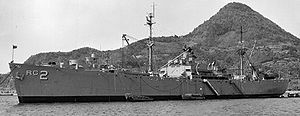USS Luzon (ARG-2)
 USS Luzon (ARG-2) moored to a buoy in Sasebo harbor, Japan | |
| Career (United States) | |
|---|---|
| Builder: | Bethlehem Fairfield Shipyard |
| Laid down: | April 8, 1943 |
| Launched: | May 14, 1943 |
| Commissioned: | October 12, 1943 |
| Decommissioned: | July 1, 1960 |
| Renamed: |
May 24, 1943 from SS Samuel Bowles |
| Struck: | September 1, 1961 |
| Fate: | Scrapped |
| General characteristics | |
| Displacement: |
4,023 tons (light) 8,700 tons (full) |
| Length: | 444 ft 6 in (135.48 m) |
| Beam: | 56 ft 11 in (17.35 m) |
| Draft: | 23 ft 0 in (7.01 m) |
| Propulsion: | reciprocating steam engine, single shaft |
| Speed: | 12 knots |
| Complement: | 521 officers and enlisted |
| Armament: |
1 × single 5"/38 dual purpose gun mount 3 × 3"/50 gun mounts 4 × 40mm AA guns 12 × 20mm AA guns |
The USS Luzon (ARG-2) was an internal combustion engine repair ship that saw service in the United States Navy during World War II. The lead ship in her class, she was named for the Island of Luzon, the chief island in the northern Philippines and site of the capital city of Manila, the second U.S. Naval vessel to bear the name.
Originally built as SS Samuel Bowles by the Bethlehem-Fairfield Shipyard, Inc. in Baltimore, Maryland, her keel was laid down on 8 April 1943 under a Maritime Commission contract; launched 14 May 1943; sponsored by Mrs. H. E. Sigman; acquired by the Navy and renamed USS Luzon (ARG-2) 24 May 1943; and commissioned 12 October 1943 with Commander Elmer R. Runquist in command. After shakedown in Chesapeake Bay, she departed Norfolk, Virginia 28 November for duty in the Pacific. She transited the Panama Canal 6 December and arrived the Ellice Islands 3 January 1944. Assigned to Service Squadron 4, she operated at Funafuti and provided repair facilities for amphibious, patrol, and landing craft. Following the invasion of the Marshall Islands on 31 January, she steamed for Kwajalein Atoll on 23 February and arrived there on 4 March. During the next 5 months, she served there as repair ship and tender for harbor craft.
As American seapower spearheaded the Allied advance across the Pacific, Luzon steamed to Guam after the conquest of the Marianas. Departing Kwajalein on 2 September, she sailed via Eniwetok and reached Apra, Guam, on the 11th of September. As a unit of Service Squadron 10, she maintained a busy repair schedule there until 1 March 1945 when she steamed to Saipan for 6 months of duty at that important harbor. Following the surrender of Japan to the Allied Powers, Luzon departed the Marianas on 1 October for Japanese waters. After touching at Iwo Jima, she reached Wakanoura Wan, Honshū on 8 October. She proceeded to Nagoya, Honshū, the 19th until 22 December, she provided fleet and repair services to ships supporting occupation operations in Japan. She then departed for the United States, and, after touching at Pearl Harbor and the Panama Canal, she arrived at Orange, Texas on 9 February 1946. Assigned to the Atlantic Reserve Fleet, she was decommissioned on 24 June 1947.
In response to the outbreak of the Korean War, Luzon was recommissioned on 20 September 1950, Commander Alan B. Sutherland in command. After steaming to Norfolk in early in October, she departed for the West Coast on 15 November. She reached San Diego on 6 December, proceeded to San Francisco on the 11th, and sailed for the Far East on 26 December. She arrived at Sasebo, Kyūshū on 23 January 1951 and during the remainder of the year, she provided valuable repair services for ships of the 7th Fleet. She departed Japan for the west coast 19 January 1952; after reaching San Francisco on 9 February, she operated out of San Francisco, San Diego, Pearl Harbor, and Long Beach during the next 15 months. Departing Long Reach on 2 May 1953, Luzon deployed to the western Pacific and arrived at Sasebo on 2 June. Except for a run to Pusan, South Korea, and back in mid-July, she provided repair facilities at Sasebo until sailing to Yokosuka on 15 January 1954. She departed the Far East for home on 2 February and arrived at Long Beach on the 28th. She was placed in commission, in reserve on 15 March 1955 while undergoing repair at Mare Island. After returning to San Diego on 29 April, she was placed in service, in reserve.
Luzon was recommissioned at San Diego on 3 November, with Commander W. F. Christie in command. After completing training off southern California, she sailed for the Far East on 9 March 1956. She arrived at Sasebo on 9 April and began duty as station repair ship for Service Squadron 3. During the next 4 years she remained in the western Pacific, supporting peacekeeping operations of the 7th Fleet. Although based at Sasebo, she steamed to Okinawa, Taiwan, Hong Kong, and to various Japanese ports while carrying out her assigned tasks. Luzon returned to San Diego on 31 May 1960 then steamed to Mare Island on 3 June for deactivation. She was decommissioned there on 1 July 1960, and her name was struck from the Naval Vessel Register on 1 September 1961.
Luzon received one battle star for her Korean war service.
While docked at the Norfolk Navy Yard in 1951, she appeared in the background of the opening scene of the film You're in the Navy Now.
References
- This article includes text from the public domain Dictionary of American Naval Fighting Ships.
- "Luzon". Dictionary of American Naval Fighting Ships. http://www.history.navy.mil/danfs/l33/luzon-ii.htm. Retrieved March 16, 2007.
- "ARG-2 Luzon". Service Ship Photo Archive. http://www.navsource.org/archives/09/29/2902.htm. Retrieved March 16, 2007.
| ||||||||
| ||||||||
